
Portrait of Lindsay Adler, Photo by Bob Trautman
10 Tips for Improving your Portfolio in 2012
New York City is filled with thousands of amazing fashion and commercial photographers, all fighting for similar clients and resources. Because of this I must constantly improve my portfolio and strive to stand out from the crowd. Yet this is not an easy task! I need to push myself to be creative on each and every project, and find ways to make my images exciting.
I’m always striving for my next shoot to be the best shoot I’ve ever done. Yes, I like my work and portfolio but I am never ‘satisfied’… and I think that’s a good thing!
I have the best job in the entire world. Hands down. I photograph beautiful people, in beautiful clothing, in beautiful locations. No complaints about that! Yet one of the biggest challenges is always getting better and finding a way to distinguish myself. I’ve always got to be improving my portfolio and defining my style. I must find ways to stop viewers in their tracks and engage them with my images.

I frequently utilize the color red as a very aggressive and visually compelling color to help give my images impact.
Below are 10 tips that I use to improve my portfolio, and I always keep these tips in the back of my mind. They help me to weed out bad images, to challenge myself creatively, and ideally to become a better photographer. Hopefully they will help you to improve in 2012!
1. Cut Weak Images
People remember your best images. They also remember your worst images. You are much better off cutting weaker images and having fewer images in your portfolio than padding your portfolio with mediocre images. Cut, cut, cut! Having 12 incredible images in your portfolio is a lot better than having 12 incredible images plus 12 average images. Aim for impact, and cut the weakest.

This image was in my portfolio for several months. Although I liked the clean yet aggressive feel of the image, it simply was not strong enough to stay in my portfolio.
2. Get Outside Critique
When deciding which images to cut and which images to include in your portfolio, get outside critique.
Sometimes you can be too emotionally attached to your images to realize that they should be cut from your portfolio. Let’s say that you hiked 7 miles in a blizzard to photograph a beautiful mountain scene. If the image is just an average landscape, then your suffering and pain doesn’t make it any better. As my friends say, “Sometimes you have to kill your babies”… referring to photographs of course!
When you get outside critique, be sure it is from someone you trust and respect. I often get outside critique from other photographers, my photo agent, and even my mom (hobbyist photographer too!). Between the several critiques I get, I can usually determine which images have the highest impact and are most successful, as well as which images need to be cut.
3. Look at Other Photographers’ and Artists’ Work
It’s not cheating to be inspired by other photographers’ and artists’ work. You can get inspiration from anywhere. When you look at other photographers’ work, you may be inspired by the lighting, composition, styling, posing, or any number of different elements.
In fact, many of my shoots are a combination of elements from many inspiration images. I save thousands of images on my computer to help communicate (visually) my ideas to my creative team when I do a shoot. I might use lighting inspired by one image, a pose from another image, and styling inspired by another photo. In the end the photograph is 100% mine regardless of the inspiration!
Obviously it’s pointless to copy an image… if it’s already been done, then there is no point in you creating or ripping off someone else’s ideas! Yet inspiration is completely legitimate whether you get inspired by a photographer, painter, location, movie, or any other source.
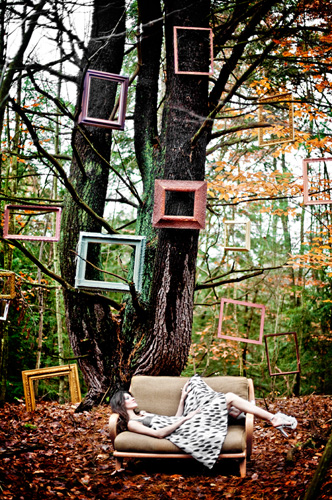
This image (of an environmental activist) was inspired by the fashion photographer Tim Walker who regularly uses grand scenes and fairytale props to create striking images.
When I look at other artists’ work, I try to really analyze what’s compelling about the images and what I can do to incorporate these elements (see #9). In the image above I was inspired by the work of Tim Walker, who regularly uses fairytale props and dramatic scenes.
4. Experiment
Don’t be afraid to step outside your comfort zone and try new techniques or types of photography. If you are landscape photography, try portraits. If you love photographing at sunset, try painting with light in the middle of the night. Look at other photographers work and try different techniques. Don’t be afraid to try new things!
For example, I saw many excellent photographers who were using paint with light as a technique for painting landscapes, urban scenes and even portraits. The images were beautiful, but looked challenging. I decided to experiment with paint with light for my fashion images, and was THRILLED with the results!

After seeing many photographers utilize paint with light in their work, I decided to experiment and use this technique for my fashion photography.
5. Define Your Style, Specialize
While I urge you to experiment, eventually you want to define your style and specialize. If you’d like to make photography your profession, you don’t want a website that has portraits, landscapes, macro and fashion. You are more likely to get a job or be memorable if you have a specialty or niche.
Even if you aren’t a professional, if you wish to exhibit your work it will be more appealing to galleries when you have a cohesive body of work. People don’t remember the ‘photographer who photographers everything.’ They remember the “food photographer” or “fairytale-inspired portrait photographer”. The more you specialize, the more you will be remembered.
I go back over and edit my portfolio ALL THE TIME. I really look at the weakest images, and attempt to replace them. Next I look at the strongest images. Why are they so successful? I try to use those same successful elements in future shoots.
I personally feel my style is clean, graphic and bold. When I shoot, I try to stick to this style, either using high contrast or bright colors to emphasize my compositions and poses.
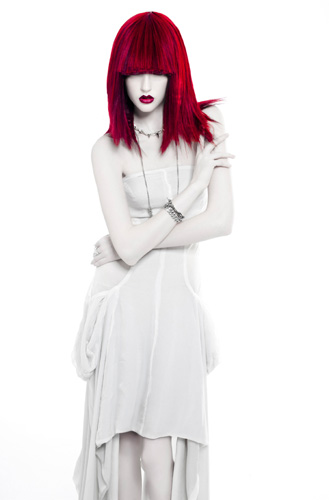
This image, shot for Papercut Magazine, fits into my style of fashion photography that is clean, graphic and eye-catching.
6. Make Mistakes
Some of my favorite images and techniques started with a ‘mistake’. We have all spent a lot of time learning the ‘rules’ of photography. Yet I often see that that images that break the rules are the ones that stand out. When I experiment I try to remember that it is okay to make mistakes, and sometimes those mistakes I like best! In fact, many photographers use these ‘mistakes’ to make their signature style.
Try adding lens flare, or motion blur, or something considered ‘wrong’ by traditional photo standards. Once when doing a shoot, someone’s clothing got in front of the lens, and it created this very interesting blur effect in the frame. Now I purposely create this blur effect, as seen in this image which recently appeared in Z!NK magazine. Sometimes ‘mistakes’ make the most interesting images.
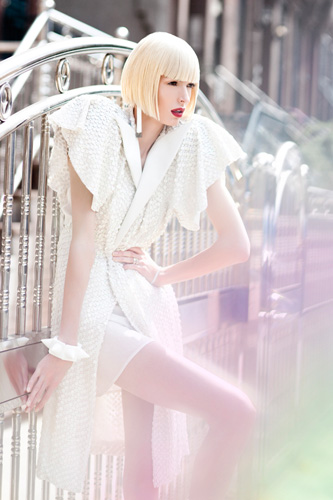
Sometimes allowing yourself to make mistakes can help you discover truly interesting effects. Here I held colored plastic in front of the lens to create this blur effect.
7. Give Yourself Assignments
Give yourself assignments and deadlines to meet those assignments. Especially if you are not a full time photographer, it can be hard to find time to shoot for yourself. By giving yourself deadlines and assignments it gives you something to work toward and concentrate on.
When I give myself assignments, I try to analyze ‘what’s missing’ in my portfolio or what I could do to improve.
Assignments can be single words like “Red” or techniques like “Religion”.
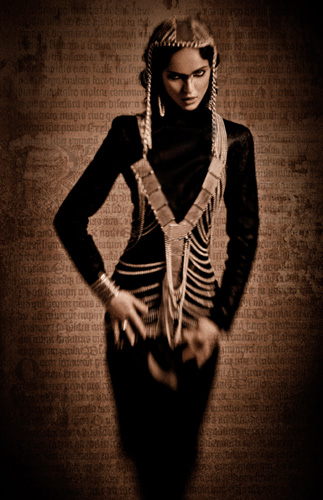
For this image I gave myself the assignment of shooting the theme “Religion.” I decided to take the ‘religious’ warrior route and utilized a Lensbaby and Photoshop to create the final effect.
8. Enter Contests
If you are struggling to come up with self assignments, look for contests to help give you assignments. You can find contests online, in magazines and much more. They might give you subject matter to focus on. Furthermore, if you do win the contest, it helps get exposure for your work and perhaps some cool prizes.
For example, my good friend Brooke Shaden has a monthly contest on her blog. The contest themes vary but always seem to spark my creativity. Find blogs, magazines or websites with competitions and shoot to win! Ok, well if not to win at least to challenge yourself and explore your creativity!
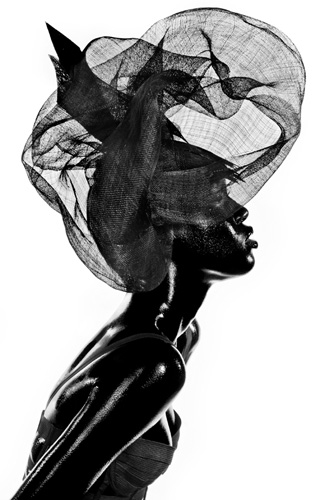
I entered this image in the PDN’s “The Look” competition and was named one of the finalists.
9. Analyze Images
Most of us know an image we love when we see it. But do we really stop and ask why? Is it the lighting that is striking? Or is it powerful subject matter? Or do you love the composition? If you analyze photographs you can start to see which elements attract you to an image. From there, you can set the goal to incorporate these elements into your own work!
For example, I find that I love really graphic compositions and bright colors, and so I always try to incorporate this into my own work. Sometimes it happens naturally, and sometimes I make a conscious decision.
I look at the photographers I truly admire, and try to figure out what makes their work so incredible, and see if I can infuse that into my own!
10. Shoot personal work
If you are a professional or aspiring professional looking to improve your portfolio, don’t just shoot client work. Put together your own creative shoots that reflect the type of work you’d like to be hired for. This shows potential clients your creative abilities. I can almost guarantee that if you ONLY shoot when you are paid to shoot, your portfolio is suffering.
Furthermore, by shooting personal work people can see your creativity and vision and perhaps open up more opportunities. I try to shoot 1 personal project a week. When I first moved to NYC to pursue my fashion career, I dedicated each Sunday to shooting some sort of personal project, and the rest of the days to getting paid gigs. My portfolio improved 10x, and really helped kick-start my career!
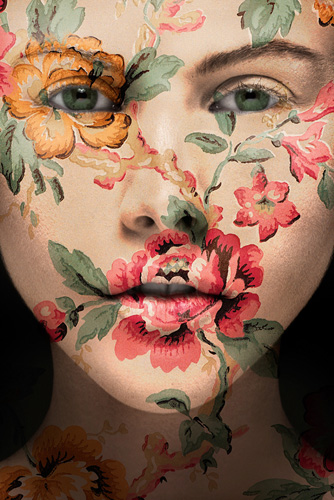
This image was inspired by a Japanese artist who projected floral patterns on a face. This started as a personal project, but later ran in several international fashion magazines.
You can view more of Lindsay’s work at LindsayAdlerPhotography.com, keep up with her on her blog, and follow her on Twitter.



An interesting article. I will certainly revisit my portfolio and get rid of the weakest images.
These are points that every photographer come across when starting putting a portfolio together, nothing new, however not easy to stick to (being critical with your own work, for instance)! It is very useful to be reminded though, making more time for personal work, …which is the reason why we got into photography, in the first place, doing what WE love!
Thanks Lindsay!
Thank you, Scott! It’s really very helpful! Some tips for me are not new, but there are some that are very interesting and useful.
Great reminder to start culling the mediocre photos out of my portfolio book. The term “killing my babies” is so appropriate.
Terrific blog post!
–John
A really inspring article. Excellent advice coupled with beautiful photos.
I will certainly be reviewing my portfolio in the very near future.
Thanks
Lindsey, awesome post and great tips, thanks for sharing that! KT
Some very interesting images. You obviously have a passion for what you do.
Thanks for sharing.
Nice article. I should rearange my portfolio as well…
Great Tips!! I’m already doing some of these but now I’ll DEF be incorporating more.
Great post and my favourite “Define Your Style, Specialize”
Thanks for great post.
Your advice couldn’t have been more timely as I’m carving out time for posting a few images soon. As always, excellent advice!
Great!!!
Awesome tips and exquisite imagery. Thanks for morning inspiration Miss Adler!